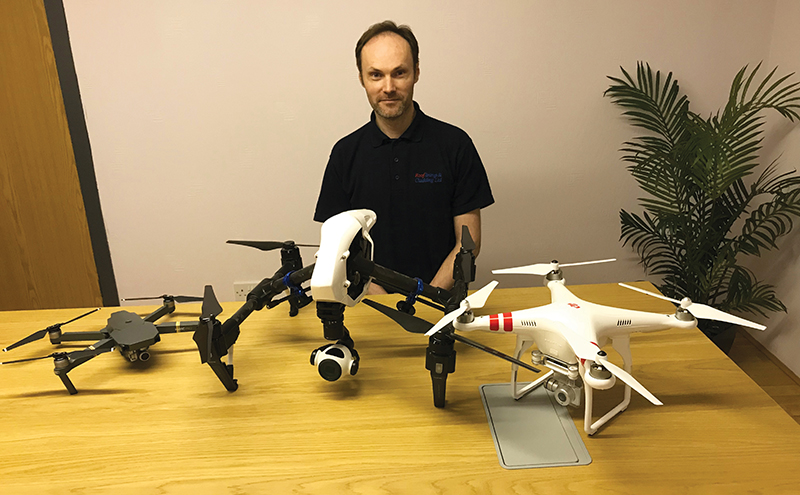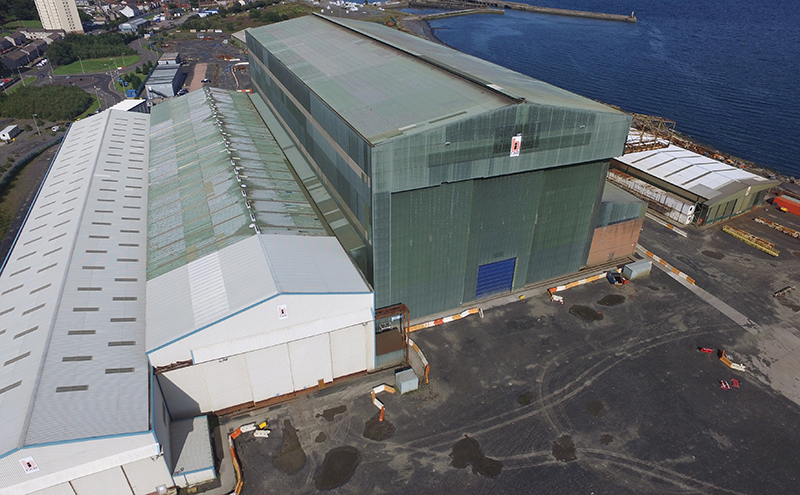
THE use of drones in the roofing sector is surging – and it’s not difficult to see why.
The technology is ideally placed to reach difficult-to-access areas of buildings or rooftops and help diagnose faults or provide vital information without a scaffold or ladder in sight.
The National Federation of Roofing Contractors (NFRC) recently launched new guidance for commercial drone operation for its members. The trade body has entered into an exclusive partnership with the Association of Remotely Piloted Aircraft (ARPAS) in a bid to ensure the use of drone technology is safe and legal.
“Roofing is defined by risk and that risk is falling off buildings or scaffold,” Mike Wharton, head of membership and commercial services at the NFRC told Project Scotland. “If you can employ a piece of technology to do the heavy lifting for you and to mitigate that risk, then that is something that’s of great interest to us, particularly in light of the rapid increase in drone technology.”
Mike explained that the new guidance for commercial drone use aims to inform its membership about the safe and correct operation of and the legal compliance involved with drone technology.
“ARPAS is the fastest growing organisation of its kind, which has a real thrust on the training side of things and the meeting of legislation. That’s the ultimate reason we chose them because we felt they were demonstrating a strong ethic in terms of where the industry is going and really representing that industry, particularly the training companies involved in drone piloting.”
Mike said that the guidance has been very positively received by its membership. “We now have some training organisations approaching us asking us to get involved with them on the basis of them putting in bids to organisations like CITB to fund drone training and drone piloting.”
He continued, “For me, I would like to see drones in every roofer’s arsenal because if they can really quickly look at a potentially defective roof, specifically a fragile roof, and they can just stand at ground level, as long as they’re meeting the legislative requirements and they’ve got appropriate equipment, right there and then is an enormous benefit, not just to industry, but in terms of the attraction to the industry…My belief is that if enough firms are interested and the demand is there that we, along with relevant funders and training companies, could possibly look at specific qualifications to do with roof investigations using drones and in doing so you’ve then got potentially a nice piece of tech involved in the industry.
“You can’t get more modern and digital than the use of drones. Within the construction industry as a whole it’s assisting in the bringing it forward into the 21st and then ultimately 22nd Century.”
One firm taking full advantage of the advances in drone technology is East Kilbride-based Rooflinings & Cladding. The industrial roofing contractor is now in its third year as a qualified operator and has been commissioned by a variety of clients to carry out a wide range of drone-related projects.
The company offers aerial photography, site surveys and health & safety reports along with roofing services including new construction, reroofing, retrofit over roofing, cladding and maintenance work as well as reparation, relining and replacement works.
“I’ve got a background in model aircraft, believe it or not,” George Drummond, construction director at Rooflinings & Cladding told Project Scotland. “I’ve done that for years and years and then about five or six years ago, the cameras that came out on drones started to be better so (the company) got interested in it.”
George purchased a drone for personal use to get a feel for it and immediately realised the potential business benefits for activities like building surveys.

“I did a bit of digging into the background and found out it wasn’t just as straightforward as buying a drone and turning up at a site,” George explained. “Initially, you do a recognised course that’s run with a company that the Civil Aviation Authority (CAA) have given a training license to. My license is called a BNUCS (Basic National Unmanned Aviation Certificate) and for that you’ve got two classifications – sub 7kg and over 7kg.”
George added that for use in roofing, it is very unlikely that a license for over 7kg would be required, as that’s more for high end filming where the camera itself is very heavy.
He continued, “With the less than seven kilogram license, you effectively go for a ground training school. I did mine at Edinburgh Airport and in there you complete a week-long course learning basically air space navigation, even things down to wind speed directions and charts, going about the process of actually notifying the right people (such as the National Air Traffic Control Service).”
Once the ground training aspect is complete, attendees have to submit an operations manual and put together a safety case of how they want to run their company.
“That then gets submitted to the CAA and once they approve that document, you’re effectively registering your company (or yourself as an individual) as an air operator,” George added. “Once you get your company or individual license as an air operator, you then move on to the next stage, which is your flight test.
“Once you’ve passed your flight exam you also have to take out aviation insurance.”

With a valid operations manual, pass certificate and insurance secured, George received a PfCO (Permission for Commercial Operations) certificate that lasts for 12 months.
Rooflinings & Cladding has completed work for commercial surveyors who require visual inspections of buildings, often to determine the cause of problems.
George cited one example of an empty car garage in Grangemouth. Drone photographs were used to find out what was wrong ahead of the firm carrying out the necessary repairs.
“We get paid for doing the drone survey but we pick up a good proportion of the (roofing) work on the back of that,” George said. “We obviously have to tender the works; it’s not granted to you because you’ve done a drone survey. You still have to go in with competitive rates and win the contracts.”
George reckons the business wins a contract following 60-70% of drone surveys.
“Where we benefit is that there are a lot of companies out there who solely have to rely on the income from the drone survey to survive, whereas that’s not what we’re doing. We basically cover costs on the drone survey to make sure that element of work isn’t a waste of time but the company thrives on the jobs it gets on the back of it.”
What advice does George have for those in the sector interested in getting hands-on with a drone?
“Getting into the business, I would always suggest that sub 7kg is plenty so focus on that license. From there, you can go through the registered body ARPAS and they will direct you to the local training centre.
“You might even be worth doing a day’s introduction if you’ve never had any background in flying drones. You can have a test fight, see if it’s something that you do want to take forward and then if it’s something you do want to do, I would definitely get a smaller drone to practice with – something that’s not going to be too costly if it all goes wrong and you bump into a tree or something.”
George also highlighted the importance of having the correct license in place, suggesting firms register with Dronesafe, a national database of qualified pilots in the UK.
He added, “If you want to be dealing with large commercial clients, they don’t want the hassle of giving work to someone without the correct licenses and insurances in place.
“If a company or a surveyor or anybody in the UK is looking to take on a qualified pilot with everything in place, today, then it’s really difficult. You might see somebody’s advert on their webpage that says that they’ve got a license but bear in mind that the licenses expire every 12 months. When was that webpage updated?”
The Dronesafe website can provide up-to-date details of everyone in a particular postcode area licensed to carry out work.
“It’s getting the word out there that the license is non-negotiable,” George concluded. “If the flight has any inkling of a commercial basis…then you need to have your license in place.”








